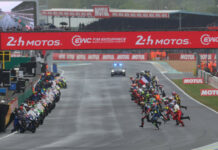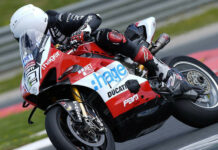The 2002 rule changes have been posted on amaproracing.com and can be found at:
http://www.amaproracing.com/rulebook/combuls/02rrchanges.pdf
Notable is the use of a blue flag with a yellow cross to designated pace car use, and the inclusion of Buells and Ducati 748s in 750cc Supersport.
No revisions to Thursday practice restrictions are included, despite strong support in the paddock, and there’s no mention of where five rounds of Pro Thunder will be held to make up for the rounds displaced from Superbike doubleheader weekends.
AMA Pro Racing announced the rulebook changes by posting a bulletin from AMA Pro Racing Technical Manager Rob King, dated December 4 and first posted December 14. The memo makes official every rule change proposed at the end of the 2001 racing season. According to the bulletin, pro racers who have applied for their 2002 license will be receiving their 2002 rulebooks in about two weeks.
The text of the bulletin follows:
General All Classes:
Current Rule: Official starting line for each starting row will be plainly marked, approximately 25 feet between each row.
Change: The official starting line for each starting row will be plainly marked with approximately 30 feet between each row to a form a grid. The starting positions on the rows will be staggered backward from the pole side of the grid resulting in slightly diagonal starting rows. Approximate stagger from position to position will be one meter. Each starting position will have a front and a rear grid mark, approximately 12″ apart, representing the area where the front tire contact patch (the area of the front tire touching the track surface) must be located for a rider to be properly staged.
Reasons For Change: This style of grid is currently used by the FIM. It provides for a more equitable representation of qualifying positions than straight across starting lines. This configuration may also have advantages for grid personnel who must watch for jump starts.
Current Rule: Should a rider’s rear axle cross the designated front grid mark at the green light signal, the rider will be considered to have jumped the start and a penalty will be assessed.
Change: Should a rider’s front axle cross the designated front grid mark at the green light signal, the rider will be considered to have jumped the start and a penalty will be assessed. This allows a rider virtually no movement before the start is signaled.
Reasons For Change: This should result in more equal starts than allowing the “rolling” as in the past. Again, the grid personnel may be able to see jump starts easier as well.
Current Rule: Refueling after the warm-up lap at the back of the grid is permitted.
Change: Refueling after the start of the warm-up lap will not be permitted.
Reasons For Change: This an unnecessary procedure considering the length of our races, fuel capacities and fuel consumption of current motorcycles. It can also cause delays in the start, fuel spills and confusion on the grid.
Current Rule: Riders listed in the top ten in points of a particular class, currently or at the end of the previous season, will be permitted a total of one provisional start per season in that class.
Change: Riders who are currently, or at the end of the previous season, listed in the top ten in points in one or more classes, will be permitted one provisional start per season in each of those classes.
Reasons For Change: We have a number of riders that are eligible in more than one class for a provisional start. These riders will be allowed a provisional start in each class in which they are eligible rather than a total of one provisional in a season.
New Rule: Riders dropping out of a race on the same lap will be scored in the order that they last crossed the finish line.
Reasons For New Rule: This occurs occasionally and is not addressed in the rule book at present. Clarification is needed to ensure consistency in scoring this type of situation.
Superbike:
Current Rule: When a race is restarted following a red flag, a rider who was present at the starting grid but was unable to start or dropped out after the start, is permitted to restart on a back-up motorcycle using the following procedure:
(1) Rider must obtain permission from the Chief Steward or Race Manager.
(2) Rider will be gridded on the last row of the restart grid.
Change: When a race is restarted following a red flag, a rider who was present at the starting grid but was unable to start or dropped out after the start, is permitted to restart on a back-up motorcycle until two laps have officially been completed (leader has crossed the finish line to begin the third lap) using the following procedure:
(1) Rider or crew must obtain permission from the Chief Steward or the Race Manager.
(2) All back-up motorcycles must be staged on pit lane or designated area and identified to grid officials.
(3) Rider will be gridded on the last row of the restart grid in a position determined by scoring.
Reasons For Change: The current rule is not restrictive enough to prevent abuse throughout a long race or a race that has multiple red flags. In addition, the current rule does not specifically stipulate that back-up bikes should be staged on the pit lane.
Current Rule: A bright orange flag indicates that the pace car is being dispatched. All riders are to hold position in regard to passing other competitors, but are instructed to close up the distance on riders ahead of them.
Change: The pace car flag will be a blue flag with a yellow cross and may be used in conjunction with a warning light/signage system. The procedures will also be changed to provide a longer warning period before the car is actually dispatched onto the racing surface.
Reasons For Change: There were complaints by riders at Daytona this year that the orange flag was difficult to distinguish from the yellow flag and therefore caused confusion. A long warning period is needed to allow the field to settle down and regroup before the pace car actually takes to the track.
600/750 SuperSport:
Current Rule: The original equipment airbox and air filter must be utilized.
Change: The original equipment airbox must be retained but the air filter may be replaced with a commercially-manufactured aftermarket filter designed to exactly replace the original OEM filter. Filtering material must be made from paper, foam or gauze. All intake air must pass through the filtering material.
Reasons For Change: Aftermarket filters are normally less expensive than OEM filters and are accepted by the rules in other organizations such as WERA.
Current Rule: The original cooling system thermostat must be in place and not modified.
Change: The original cooling system thermostat may be removed or modified.
Reasons For Change: The thermostat is not needed and costs nothing to remove. A nonfunctioning thermostat could lead to overheating and possibly a fluid spill on the track.
Current Rule: The 750 SuperSport regulations currently do not allow exceptions for twin-cylinder motorcycles to have additional modifications or to be larger in displacement than 750cc.
Change: The following displacement limits for twin cylinder four-strokes will be permitted:
600cc-750cc four-stroke liquid-cooled twin cylinders
700cc-1350cc four-stroke air-cooled twin cylinders
Twin cylinder four-strokes will be allowed the same modifications currently allowed in the Pro Thunder class with the exception of tires. The Pro Thunder minimum weight of 380 pounds will apply.
Reasons For Change: This change will give the Buells and Ducati 748’s another program to compete in. Additional brands in competition could enhance and individualize the class as well.
250 Grand Prix:
Current Rule: Fluid containment fairings are required on all four-stroke motorcycles.
Change: Fluid containment fairings will be required on all motorcycles. Required fluid containment volume for two-stroke motorcycle fairings is 1.5 quarts.
Reasons For Change: Two-stroke 250 Grand Prix motorcycles have been exempt from this rule. Experiences with oil and coolant spills this season have shown that two-stroke motorcycles should be equipped with fluid containment fairings as well.
Should you have any questions concerning these changes, please contact Technical Manager Rob King at (614) 856-1910, extension 1230 or Director of Competition Merrill Vanderslice at (614) 856-1910, extension 1262.
AMA Releases 2002 Rule Changes, Still No Word On Where Pro Thunder Will Race
AMA Releases 2002 Rule Changes, Still No Word On Where Pro Thunder Will Race
© 2001, Roadracing World Publishing, Inc.






